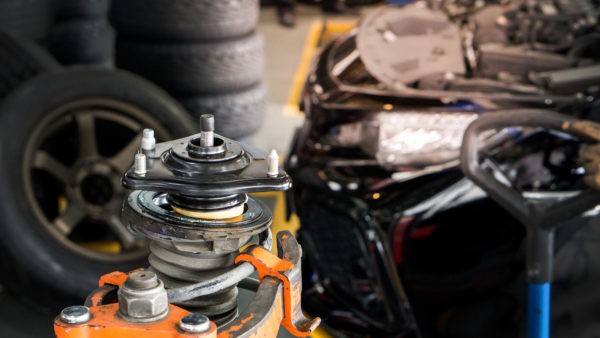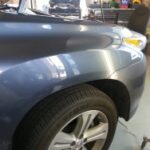 Diagram illustrating the components of a car suspension system, highlighting the shock absorber and its role in vehicle stability.
Diagram illustrating the components of a car suspension system, highlighting the shock absorber and its role in vehicle stability.
For a smoother, safer, and more controlled driving experience, your vehicle relies heavily on its shock absorbers. These vital components of the suspension system are designed to cushion impacts from uneven road surfaces, ensuring your tires maintain consistent contact with the ground. When shock absorbers start to fail, ride comfort diminishes, handling becomes less precise, and braking distances can increase. Understanding how to identify, address, and when necessary, repair car shock absorbers is crucial for every vehicle owner.
Understanding the Role of Shock Absorbers and Struts
Often used interchangeably, the terms “shocks” and “struts” refer to key parts of your car’s suspension. Both are designed to absorb and dampen the energy from bumps, potholes, and road imperfections. Without them, your vehicle would bounce excessively, making for an uncomfortable and potentially unsafe ride.
While both serve the purpose of damping suspension movement, a strut is a more structurally integrated component. A strut combines the shock absorber with the coil spring and provides structural support for the vehicle’s suspension and wheel assembly. A shock absorber, on the other hand, is primarily a damping device, often working in conjunction with a separate spring.
At the heart of both shocks and struts is a piston moving within a cylinder filled with hydraulic fluid. As the suspension moves, this fluid is forced through valves and narrow passages, creating resistance. This resistance controls the speed at which the suspension compresses and rebounds, effectively managing the energy from road impacts. This controlled movement is what prevents your car from bouncing uncontrollably.
The function of shock absorbers extends beyond just ride comfort. They play a critical role in:
- Maintaining Tire Contact: By minimizing bounce and vibration, shocks ensure your tires stay firmly planted on the road, maximizing grip for better handling, especially during cornering and braking.
- Enhancing Braking Performance: Effective shock absorbers prevent weight transfer from shifting excessively during braking, helping to maintain vehicle stability and reduce braking distances.
- Reducing Wear and Tear: By absorbing road shocks, they protect other suspension components, tires, and even the vehicle’s frame from undue stress and wear.
Typically, vehicles are equipped with four shock absorbers or strut assemblies, one at each wheel. Although designed for durability, they are subject to wear and tear over time and mileage. While lifespan can vary based on driving conditions and vehicle type, many manufacturers suggest considering replacement around the 50,000-mile mark, although modern shocks can often last significantly longer under normal driving conditions.
Recognizing the Signs of Worn Shock Absorbers
Knowing when your shock absorbers are failing is important for maintaining vehicle safety and ride quality. Here are common symptoms to watch out for:
- Excessive Bouncing: This is perhaps the most tell-tale sign. If your car continues to bounce several times after hitting a bump or dip in the road, your shocks are likely worn. A simple “bounce test” can help confirm this: push down firmly on each corner of your vehicle and release. If the car bounces more than twice, it’s a strong indication of weak shocks.
- Leaking Fluid: Shock absorbers contain hydraulic fluid. If you notice a wet, oily film or fluid leaking from the shock absorber unit, it signifies seal failure and loss of damping capability. Even a minor leak indicates a need for replacement.
- Nose Diving or Squatting: During braking, if the front of your car dips excessively (nose dives), or during acceleration, the rear end squats down significantly, it suggests the shocks are not controlling weight transfer effectively.
- Uneven Tire Wear: Worn shocks can cause tires to bounce erratically, leading to uneven wear patterns, particularly “cupping” – scalloped dips appearing around the tire tread.
- Vehicle Swaying or Leaning in Turns: If your car feels unstable or leans excessively when cornering, it could be due to weak shocks failing to control body roll.
- Unusual Noises: Knocking or clunking sounds, especially when driving over bumps, can indicate worn or damaged shock absorber bushings or internal components.
- Vibrations in the Steering Wheel: Worn shocks can transmit vibrations directly to the steering wheel, particularly noticeable at higher speeds or on uneven surfaces.
- Extended Braking Distance: Ineffective shock absorbers can reduce tire contact during braking, leading to longer stopping distances, compromising safety.
- Ride Discomfort: A general decline in ride comfort, where you feel every bump and imperfection in the road more intensely, is a clear indicator of deteriorating shock absorber performance.
Factors That Contribute to Shock Absorber Wear
Several factors can accelerate the wear and tear on your vehicle’s shock absorbers:
- Rough Road Conditions: Regular driving on roads with potholes, cracks, uneven surfaces, or unpaved roads puts significant stress on shocks, leading to faster wear.
- Heavy Loads and Towing: Consistently carrying heavy loads or towing trailers increases the workload on shock absorbers, causing them to work harder and wear out sooner.
- Aggressive Driving Habits: Driving at high speeds over bumps and potholes, or engaging in hard braking and acceleration, can prematurely damage shocks.
- Environmental Factors: Exposure to road salt, moisture, and extreme temperatures can cause corrosion and damage to shock absorber seals and components.
- Mileage and Time: Like any mechanical component, shock absorbers naturally degrade over time and mileage due to internal wear and tear of seals and valves.
How to Address Worn Shock Absorbers: Repair or Replace?
When you suspect your car’s shock absorbers are failing, the question arises: can they be repaired, or do they need replacement?
Repairing Shock Absorbers: In most cases, “repairing” car shock absorbers in the sense of rebuilding or fixing internal components is not a practical DIY task and is rarely done, even professionally, for standard passenger vehicles. Shock absorber repair typically requires specialized equipment, expertise in shock absorber mechanics, and access to internal parts, which are often not readily available for individual components. Historically, some specialized shops might rebuild shocks for classic cars or high-performance applications, but for modern vehicles, replacement is almost always the recommended and more cost-effective solution.
Replacing Shock Absorbers: Replacement is the standard procedure for addressing worn shock absorbers. This involves removing the old units and installing new ones. While some experienced DIYers with the right tools and mechanical knowledge might attempt shock absorber replacement, it’s generally recommended to have this work performed by a qualified mechanic.
DIY Inspection and Assessment: You can perform some basic checks yourself to assess the condition of your shock absorbers:
- Visual Inspection: Look for signs of leaks, damage to the shock housing (dents or rust), and condition of the bushings (cracked or deteriorated rubber parts).
- Bounce Test: As described earlier, perform the bounce test at each corner of the vehicle to check for excessive bouncing.
Professional Inspection and Replacement: For accurate diagnosis and safe and effective repair, it’s best to:
- Schedule a Suspension System Inspection: Take your car to a trusted mechanic for a comprehensive inspection of the suspension system. They can accurately assess the condition of the shock absorbers, struts, and related components.
- Consider Pair Replacement: Shock absorbers are typically replaced in pairs (either both front or both rear) to ensure balanced suspension performance and even wear on both sides of the vehicle. Replacing all four shocks or struts at once is often recommended, especially if the vehicle has high mileage or if multiple shocks are showing signs of wear.
- Sway Bar and Related Components: During shock absorber replacement, the mechanic will also inspect related components like sway bar links and bushings. These parts can also wear out and may need replacement at the same time to ensure optimal suspension performance.
Conclusion: Prioritizing Shock Absorber Maintenance
Properly functioning shock absorbers are essential for your vehicle’s safety, handling, and ride comfort. Recognizing the symptoms of worn shocks and addressing them promptly is crucial for maintaining a safe and enjoyable driving experience. While DIY inspection can help identify potential issues, professional diagnosis and replacement are generally recommended to ensure the job is done correctly and safely.
If you are concerned about your car’s shock absorbers or suspension system, schedule a check-up at a reputable service center like Car Repair Online. Our experienced technicians can assess your suspension components and provide the necessary maintenance or replacements to keep your vehicle riding smoothly and safely.

